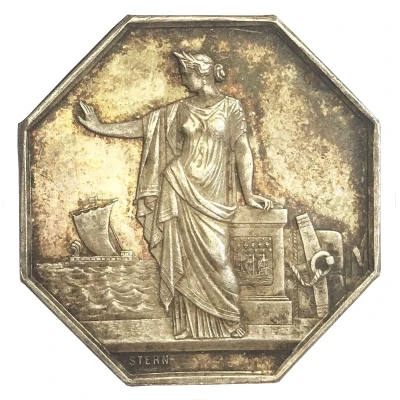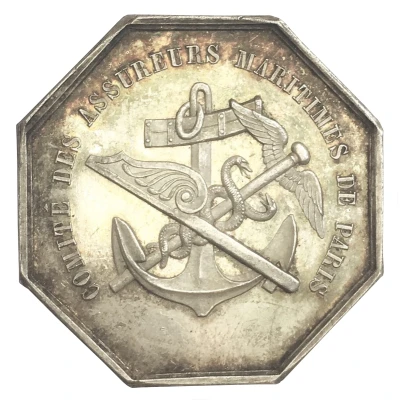


© apuking (CC BY-SA)
Token - Comite des Assureurs Maritimes Paris ND
| Silver | 17.92 g | 33.2 mm |
| Location | France |
|---|---|
| Emperor | Napoleon III (Napoléon III) (1852-1870) |
| Type | Attendance tokens › Bank and insurance company shareholder tokens |
| Years | 1860-1879 |
| Composition | Silver |
| Weight | 17.92 g |
| Diameter | 33.2 mm |
| Thickness | 2.5 mm |
| Shape | Octagonal (8-sided) |
| Technique | Milled |
| Orientation | Medal alignment ↑↑ |
| Demonetized | Yes |
| Updated | 2024-11-13 |
| Numista | N#161641 |
|---|---|
| Rarity index | 97% |
Reverse
Ships rudder and caduceus crossed over anchor.
Script: Latin
Lettering: COMITE DES ASSUREURS MARITIMES DE PARIS.
Edge
Plain with mintmark and inscription.
Script: Latin
Lettering: ARGENT
Comment
INSURANCEUnder the Ancien Régime, insurance was primarily a maritime activity. It was a contract under which a private individual undertook to make good any losses resulting from a shipwreck, in return for a certain sum paid in advance. In 18th-century Bordeaux, for example, marine insurance was concentrated in the hands of a few major shipowners, such as François Bonnaffé. An ordinance issued in 1681 allowed the greatest possible freedom in the relationship between insurers and policyholders, resulting in a proliferation of players in the market. Again in Bordeaux, companies from Paris, the Netherlands and England began to appear...
Non-maritime insurance was a latecomer to the market (mid-18th century). In most cases, they offered coverage against fire. For example, in 1753, the Compagnie d'Assurances Générales was granted a privilege by Louis XV to guarantee maritime trade and insure houses against fire.
The 19th century saw the emergence of innumerable companies, often specialized in highly specialized sectors, which helped to develop the economy by pooling risks. They were complemented by mutual associations and mutual aid societies.
![Bal Barthélemy - Carnaval [75] front](/storage/images/Bal-Barthlemy-Carnaval-1859-75_303731_1.webp)
![Bal Barthélemy - Carnaval [75] back](/storage/images/Bal-Barthlemy-Carnaval-1859-75_303731_2.webp)
![Jeton - Casino des Sables-d'Olonne [85] ND front](/storage/images/Jeton-Casino-des-Sables-dOlonne-85_426035_1.webp)
![Jeton - Casino des Sables-d'Olonne [85] ND back](/storage/images/Jeton-Casino-des-Sables-dOlonne-85_426035_2.webp)